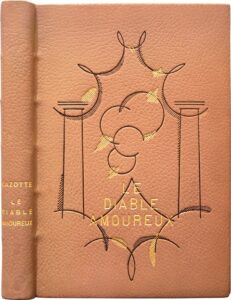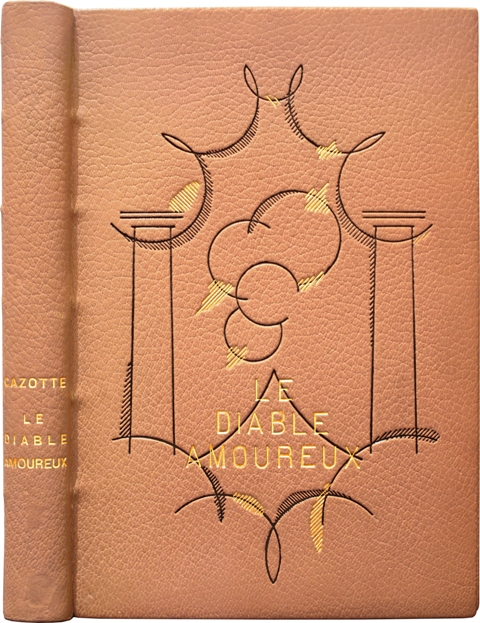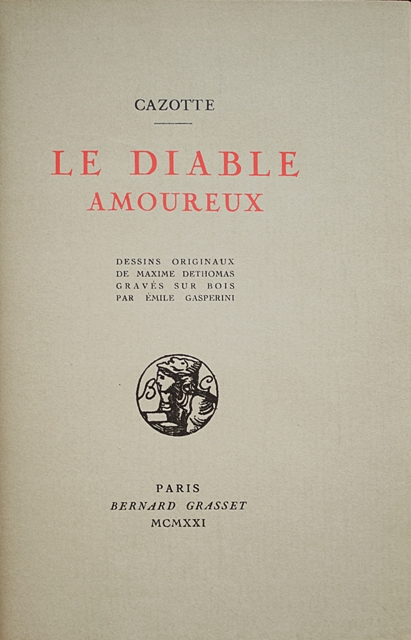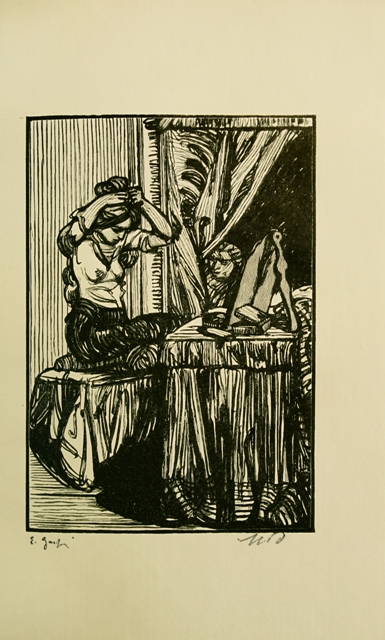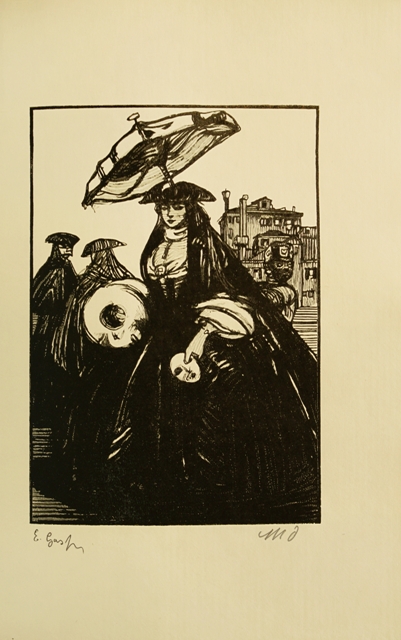CAZOTTE. Le Diable amoureux. Paris, Bernard Grasset, 1921. 8vo [229 x 155 mm] of (2) bl. ll., (2) ll., 171 pp., (3) pp., (1) bl. l. and 27 woodcuts in the text, plus a suite of 27 engravings on Japan paper. Printed on a grey paper. Bound in straight-grained pink morocco, a large pattern of blind-stamped fillets and a play of compass on the upper cover with the gilt title in the center, flat spine with gilt title, triple inner gilt fillet, doublures and endleaves of watered paper, untrimmed, wrappers and spine bound in. Binding signed Pierre Legrain and René Kieffer.
Rare and beautiful illustrated edition of Cazotte’s ‘Devil in Love’, printed by Grasset in 1921 in a run of 57 copies, one of 5 copies on grey baroque laid paper, with a suite of woodcuts printed on Japan paper, this one numbered 69.
“Original drawings by Maxime Dethomas, wood-engraved by Emile Gasperini”. (G. Décote, L’itinéraire de Jacques Cazotte (1719-1792), p. 585).
Written in 1772, a work at the crossroads of the coming-of-age novel and the fantastic short story, ‘The devil in love’ is considered as the first great French fantastic story.
A young man, Alvare, decides to call the devil. The devil appears to him as the gracious Biondetta. Alvarre decides to marry her. At the final moment, Biondetta shows her true colors to remind him that she is Belzébuth.
“Cazotte published the book which he really owes his glory to: ‘The Devil in Love’ (1772). This fantastic story remains, unquestionably, one of the little masterpieces of XVIIIth century literature.” (Dictionnaire des auteurs, I, p.543)
According to Nerval, “The Devil in Love, worthy of having its place in the fairies’ Cabinet bears the mark of the XVIIIth century, half-frivolous half-serious. The work reveals, in addition to the author’s genius, the moral condition of the society and remaining marks of superstition. According to Nerval, the XVIIIth century is not only the rational and skeptical age of Enlightenment; it is also marked by mythology and superstition, and ‘The Devil in Love’ announces the romanticism to come.” (K. Tsujikawa, Nerval et les limbes de l’Histoire, p.158).
The present edition is illustrated with 27 beautiful engravings made from Maxime Dethomas’ drawings and wood-engraved by Emile Gasperini. The copy also includes an additional suite of these same woodcuts printed out of pagination on Japan paper.
A friend of Toulouse-Lautrec, Maxime Dethomas (1867-1929) was a French drawer, painter and decorator.
A superb copy preserved in its contemporary binding drawn by Pierre Legrain and executed by René Kieffer, which will be reproduced in Art et Décoration, 1923, p.9.
Passionately fond of drawing from early on, Pierre Legrain (1889-1929) is noticed by the decorator Paul Iribe and becomes his partner. In 1917, the collector and sponsor Jacques Doucet suggests to Pierre Legrain to realize bindings, and thus, gives him the occasion to appear as a revolutionary actor in this art. Legrain used to draw bindings without executing them himself, taking some established binders on as partners, and in particular Kieffer, as it is the case here. In complete contrast to the floral patterns dear to Marius Michel, Legrain suggested abstract geometrical patterns running continuously on the covers and on the spine, of which he suppressed the ribs. Another of his innovations was to introduce the letter as a component of the décor. From 1919, Legrain stops working as the exclusive binder of Doucet and also works for other great amateurs, in particular Robert de Rotschild and Henri de Monbrison.
“Pierre Legrain made a radical change by using all the geometrical shapes executed with a ruler, a set square and a compass. He brought new elements in his creations. Pierre Legrain renovated the title position by considering the upper cover of a binding as a kind of general frontispiece on which had to appear the name of the author or the one of the book. It’s with René Kieffer that he co-operated from 1919 to 1923.”
An important binding, very early among Pierre Legrain‘s work, executed in 1921.
It contains, on the second hand-leaf, a printed label indicating “René Kieffer, Reliures d’Art”.
According to our researches, among the French public Institutions, only the National Library of France would own this rare edition.
